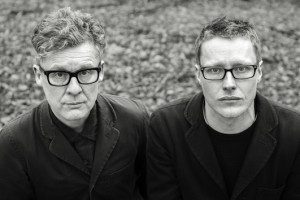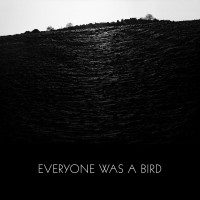Grasscut
Everyone Was a Bird (Lo Recordings)
In her recent book The Human Age: The World Shaped by Us, Diane Ackerman argues that “our relationship with nature has changed . . . radically, irreversibly, but by no means all for the bad. Our new epoch is laced with invention. Our mistakes are legion, but our talent is immeasurable.” This particular tension, one that positions people as beings who stand both inside and outside of the “natural,” seems to serve as a thematic motor for Everyone Was a Bird, the most recent LP from Grasscut, a Brighton duo comprised of Andrew Phillips and Marcus O’Dair. Between them, these guys already boast a number of high-profile achievements. Their music has been nominated for an Emmy, and used by big names like HBO, the BBC, and Mazda. Grasscut’s new album wants to be dense, polyphonic, and, to be sure, ambitious. Mostly, it delivers.
—On Liner Notes—
If Western society is preoccupied with interpreting humankind’s role within an increasingly human-tinged natural environment, this fixation apparently extends to the interpretation of artworks as well. Take the liner notes for Everyone Was a Bird: composed by writer/Grasscut enthusiast Robert Macfarlane, these “notes” (they total over 1,500 words) function as equal parts music review and teacher’s guide. Macfarlane provides ample interpretive data, lest we dull listeners fail to grasp Grasscut’s frequent geographical and literary allusions. Several titans of English literature are name-dropped, including Great War poets like George Oppen, Siegfried Sassoon (the album’s title borrows from a Sassoon poem), and Hedd Wyn, as well as more obvious picks, like T.S. Eliot (one wonders why Conrad and Woolf aren’t invited to the party).
Track-by-track, Macfarlane schools us on how to appreciate Grasscut’s choices in both instrumentation and lyrical construction: “‘Halflife’ imagines [Hedd] Wynn as a post-nuclear apparition trapped in an 8mm film-loop by the shores of the lake . . . It’s a track that works its way under the mind’s skin. It flickers itself, moving in and out of clarity.” Thanks, Rob. There’s little need for us to ponder these lines, since you’ve already explained how we should interpret them. What fun!
Perhaps we should remain open-minded. Equipping your album with literary footnotes may seem like a pretentious move, but it’s one that some listeners will appreciate, especially those who—like me—would have glossed over many of Grasscut’s painstaking references. Some might be pleased to learn that Everyone Was a Bird is “an album born of footfall”—a walking chronicle, with each track corresponding to a particular place, pace, and topography, ranging from the island of Jersey, to the South Downs, to soupy Welsh estuaries. As Macfarlane points out, many of Grasscut’s lyrics hint at a certain uneasiness about humankind’s encroachment on sacrosanct natural landscapes, expressing all the usual nostalgia for the world in its pristine, pre-industrial state. I won’t belabor the album’s copious bird references, or the possible nods toward transcendence that those references entail, as this sort of ground is well-trod (to borrow a term that Phillips favors: “fallow”).
—The Album, Actually—
Now that we’ve covered the liner notes, we can dismiss them, and focus instead on what the album actually does. Maybe, like this reviewer, you’ve never crossed The Pond. That doesn’t mean you won’t connect with the album’s thematic interests. We’ve all experienced technological estrangement, and we’ve all seen a plot of lovely woods become paved over by yet another fried poultry franchise.
and we’ve all seen a plot of lovely woods become paved over by yet another fried poultry franchise.
How to define Grasscut’s sound? Categorizing any compelling band becomes an exercise in violence. Everyone Was a Bird is not “post-rock” in the manner of Explosions in the Sky, or Mogwai, or Mono, or any of the coattail riders that follow in their wake, but some of Grasscut’s instrumental swells might fit that general zeitgeist. The album’s bones are hewed from electronic instruments and beatbox patterns, though you’d never hear one of these songs on “Echoes,” NPR’s late-night narcotic program. There’s more urgency here, more pep—it’s as if the Anglo-Icelandic group Fields stayed up late drinking chilled vodka and reading trench poetry, and somehow they knocked up a drum machine. Vocals are always clear in the mix, and in Grasscut’s sonic universe, they carry a great deal of weight.
It’s likely no coincidence that the same “nature vs. artifice” tensions that show up in the album’s lyrics also find expression in the instrumentation. Put differently: Grasscut’s bones may be electronic, but its heartbeat is good and warm. The majority of EWAB’s eight tracks build upon very simple, yet evocative melodies. These slow-burners gain mass as Phillips, O’Dair, and scores of musician-friends pile on a litany of live sounds: glockenspiel, piano, double bass, viola, violin, you name it. The tug-of-war between metrically perfect programmed instruments and those of the less precise, hand-wrought variety is what gives lift to these tracks.
—The Briefest of Track-by-Tracks—
Islander: crystalline marimba key tones push against a hissy, beatbox groove. It’s the gaps that really sell the isolationist flavor of this one. Dig the lyrics: “The water is cold / so green against the granite.” The water is cold, indeed! So much loneliness in this track, so why do you feel the urge to dance?
Radar: this one’s 7/8 time signature will put a delightful stutter in your dancing foot, but dance you will, to warmer drums, and eerie, Twin Peaks-ian background swells. “So let in the light / If the world is dark as radar.” If you’re wondering what to make of a line such as that, consult Macfarlane. He’s got plenty to say.
Curlews: piano-fed, to the point of waltziness. Strings to match today’s higher-end Allstate commercials. We find glimpses of transcendence: “In the glittering estuary mud / trailing their footprints before the flood.” In Grasscut’s ethereal world, even wetlands muck glitters, by Jove!
Fallswater: here, Phillips’ lyricism and love for rhyme and alliteration reach new heights: “Sing, sing, sing of the spray and the wavelengths of light / everyone’s suspended in the blink of an eye.” Shadow and darkness provide thematic tension, the veiled threat of encroachment mimicked by the chaotic swell of drums, strings, and horns.
Halflife: a clear standout track, with brilliant call-and-answer between vocals and strings. “He walks, he walks, beside the lake / fade in, fade out, a loop he makes / through silver birches flickering / by concrete towers, he disappears.” You might pick up on the tension between the nuclear power plant in Trawsfynydd and its natural surroundings, or you might not. Do you need to understand these references in order to appreciate the song? Unlikely.
Snowdown: this one’s more soporific. The piano’s on valium, the drums are snoring, and the fields are apocalyptic with winter. “Snow has come again / Snow has come again / See it on the power lines / See it fall again.”
The Field: a delicious pairing of guitar and strings dissolves into bare vocals, then builds heat. Rinse, repeat. “The one who walks beside you / he never yields / follow the tracks and verges / all along the fallow fields.” Of course the fields are fallow. TS Eliot would approve. Still, you could dance to this one.
Red Kite: another standout, with a haunting string rhythm that Andrew Bird would just love to cop, all set against a busy snare drum ditty. Lyrical tension builds nicely, if predictably. We transition from the pastoral (good!) to industrial copper mines and slag heaps (bad!). “There’s a red kite flying above the pines,” but it’ll have to contend with “concrete towers and power lines.”
—Speaking of Birds—
In the case of Everyone Was a Bird, mysteries prevail, and I can’t help suspecting that for all its intertextual bluster, the album is often a mystery to itself: am I a pastoral snapshot, or an alarm bell? A fight song, or a dirge? Macfarlane would have us believe that this is one heady tome of an album, thick with allusive might, allegories, and insights, but the end of the album leaves us with a rather cryptic quote that Sassoon wrote nearly one hundred years ago: “O, but Everyone. Was a bird; and the song was wordless.” Okay, sounds nice, but what’s the takeaway? In the face of industrialization, we must soar like birds? A bit flimsy, maybe, not to mention familiar. Within the realm of indie rock, the bird-as-freedom trope is overused, just ask Godspeed’s Efrim Menuck. Diane Ackerman, Slavoj Žižek, and a host of other philosopher-theorists have already undermined this kind of nostalgic “back-to-nature” thinking, and let’s face it: the modernized society-as-wasteland motif is about as fresh as Grandma’s ribbon candy.
Bottom line: EWAB does a fine job of articulating the ecological price of modernization, but despite its high-brow reference work, the album never feels as smart or profound as it would like to be. Arguably, this potential shortcoming works to the album’s advantage: we’re left with well-constructed tunes that are joggable, danceable, sexable, or—should you choose—broodable. Phillips and O’Dair provide us with a memorable, and truly appealing fusion of digital and analog voices. Maybe that’s ambition enough.




